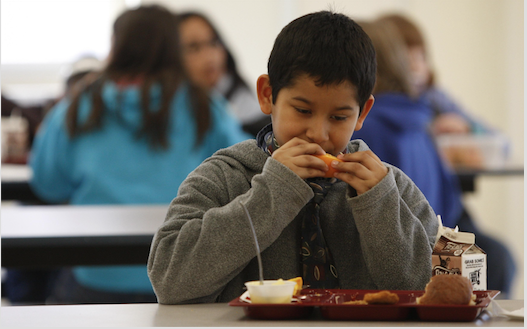
By BENJAMIN ROCHETEAU
Staff Writer
The average high school student is fourteen to eighteen years old, performs some form of exercise and is growing into an adult. These components engender calorie-intensive work. The average teen requires between 1800 and 3200 calories per day depending on age, weight, sex, and frequency and intensity of exercise.
Getting these calories isn’t easy; teens have a tendency to eat a light breakfast – if they eat one at all – and they have only thirty-five minutes to eat lunch. They must obtain the rest of their calories through dinner and snacking. This means that most calories are obtained during dinner, yet studies show that the best way to stay healthy is to have a more calorie intensive breakfast and lunch and a light dinner. A light dinner is beneficial because the body stores calories for four to eight hours before turning them into fat, meaning that excess calories consumed during dinner are then turned to fat during the 7 to 10 hour period of sleep following the meal. But if those excess calories were consumed during breakfast or lunch, many more of them would be burned off by the student’s daily activities, resulting in less of those calories being transformed into fat.
When kids do not have the time to eat a proper breakfast, many skip it, which leaves lunch and snack to obtain nutrition and alleviate hunger. The problem with this is that kids are simply unable to consume enough calories during the measly fifteen and thirty-five minutes allocated by the school schedule for snack and lunch respectively.
Without time during breakfast or lunch, many eat more during dinner or simply eat more overall, both of which are not necessarily good. So why are these guidelines in place? They aim to fight the nationwide epidemic of obesity, which affects around thirty-six percent of this country’s population. Another reason is to make students follow what the state and district consider to be more “healthy choices,” since they do not consider teenagers able to make those decisions themselves. These guidelines are inherently flawed, which prevents them from working as well as they should.
The IUSD nutrition guidelines heavily restrict the amounts of sodium, calories and fat in the food schools sell. This makes it much harder for schools to provide meals which adhere to these guidelines, as the new products are often less appetizing and more expensive. The fact that large companies lobby to have their products bought by the government for student consumption does not help the issue either. To them, the school lunch is a several billion dollar industry that they wish to exploit as much as possible.
The guidelines also force kids to purchase fruits and vegetables along with their meals. The cafeteria may say that they are free, but the truth is that the price is simply tacked on to the price of whatever meal you are buying. So if you pay three dollars and fifty cents for a pizza and an apple, you are really paying two dollars and fifty cents for the pizza and another entire dollar for the apple. Making kids take these fruits and vegetables does not work, since there is no way to make sure they eat the fruits and vegetables. While it may increase the number of kids eating them, it may also increase the amount of food waste.
Nutrition guidelines, by limiting the kinds of foods that schools can sell, leave less appetizing choices behind. This promotes eating off campus, where the school cannot regulate what kids eat. The measures are a lot less effective because a large percent of students do not actually eat at school. If schools were able to provide better lunches to students and make eating at school more appealing than eating off campus, then more students would actually eat school lunches. This, in turn, would increase the schools’ profits and give them more influence over what kids actually eat. The problem with providing better lunches is simple: the schools do not have enough money, since the government spends less than 15% of their budget on education, which is arguably the most important department to which they should send money.
There have been some serious attempts to solve the problem in the past. The biggest one is Michelle Obama’s initiative. It is a voluntary program which school districts are encouraged but not required to participate in. It provides free, healthy lunches to all children, regardless of financial status. It has received severe criticism because of its lack of long term goals, and because of the financial strain it places on the government. However, it has seen remarkable results in getting kids to eat more healthy foods, and it has led to an increase in school cafeteria profits, according to a USDA report. But it is not enough. There are still problems to solve.
There are three possible solutions to this problem. The first one would be to make all the students eat school lunches, which would be met with large amounts of protest from the parents and students. The second would be to make the lunches more appealing to the students, which would require a compromise between healthy and traditionally tasty meals, and would require more money than the government would be willing to spend on its students. The third and most feasible option is to simply make the nutrition guidelines less restrictive and let students take care of their own health with guidance from their parents. Kids will not get healthier if they do not want to put in the effort to do so. But this solution will likely be met with resistance from the government and district, who are reluctant to trust the students with their own health. To solve the issues created by the nutrition guidelines’ measures, the district needs to make a decisive choice regarding the student’s food. To stay in between makes no impact. The change will require a group to make concessions, but it is the only way to make a lasting impact on health of the students.
The sad fact is that, apart from Michelle Obama and her initiative, no groups actually make the intake of vitamin and minerals a priority. The government has to balance budgets for all of their programs, and juggle this with the the national debt and limited funds. The school district has to satisfy government regulations while staying within its budget. Students just want a good meal; you cannot realistically expect them to care about nutrition. So, the students get ignored, but the district still does not take the needed steps to improve lunches because want to satisfy all parties, which is admirable in theory, but does not work in practice. The school district ends up providing cheap, somewhat appetizing meals, which somehow meet government regulations.
In the end, nobody is outraged, but nobody is satisfied either. It is time for the district to make a decision, and choose a group to please, and a group to displease. Some groups will be content, and some will not. But progress will be made; after all, not all problems have a solution which makes everybody happy.













